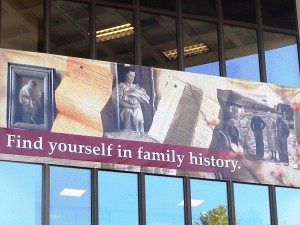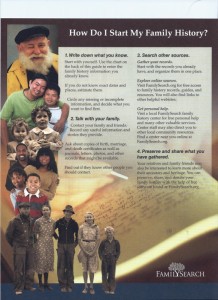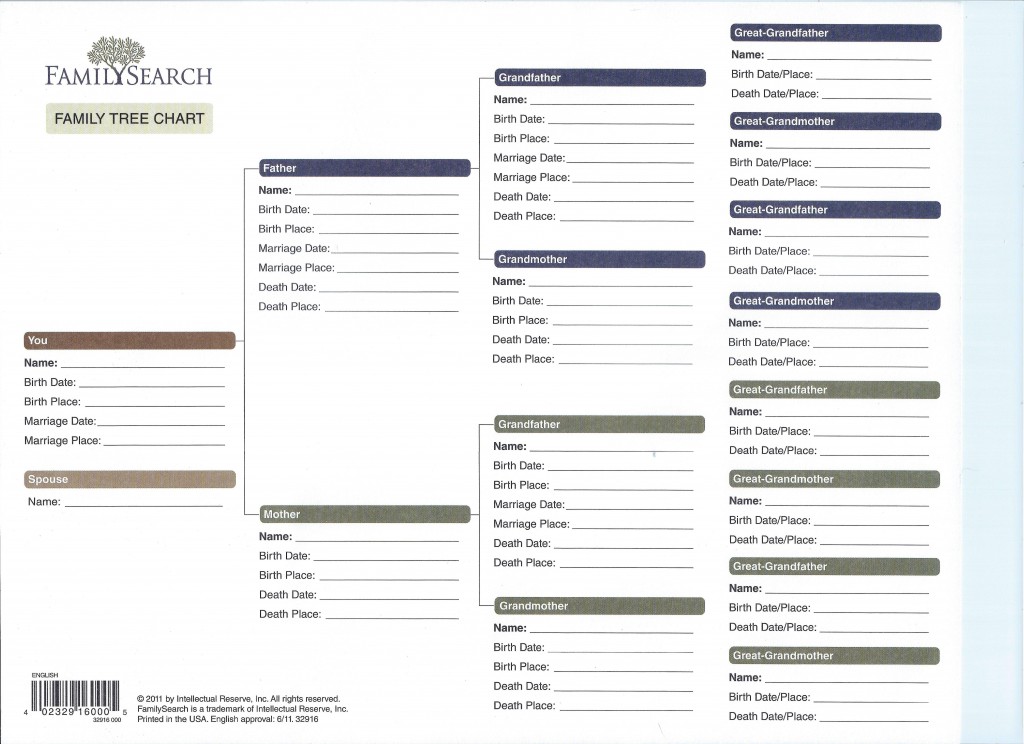» posted on Tuesday, May 8th, 2012 by Linda Lou Burton
Going Backwards
 Linda Burton posting from Salt Lake City, Utah –“In my opinion,” I said to the librarian at the Family History Library, “every American history class should begin with teaching students how to trace their own family history at least four generations back.” A nod, of course, from one who spends her day surrounded by the largest collection of genealogical records in the world, containing the names of more than three billion deceased persons. People come from all over the world to delve into the two million rolls of microfilmed records here, assisted by staff who offer guidance in maneuvering the intricacies of such a voluminous storage vault.
Linda Burton posting from Salt Lake City, Utah –“In my opinion,” I said to the librarian at the Family History Library, “every American history class should begin with teaching students how to trace their own family history at least four generations back.” A nod, of course, from one who spends her day surrounded by the largest collection of genealogical records in the world, containing the names of more than three billion deceased persons. People come from all over the world to delve into the two million rolls of microfilmed records here, assisted by staff who offer guidance in maneuvering the intricacies of such a voluminous storage vault.
Founded in 1894 to gather genealogical records and assist members of The Church of Jesus Christ of Latter-day Saints with their family history and genealogical research, the library is open to the general public at no charge, and the services are well-utilized; visitors average 1,500 a day. You are greeted at the door with a smile, welcomed in, and offered a name tag. You are given the floor plan of the building so you can find your way around the four floors, a Family Tree Chart so you can begin to fill in the blanks, a research log so you can pinpoint your goals for the day and document your accomplishments, and a freshly sharpened pencil. You’ve been greeted, and armed; now you are directed or escorted to the room, or floor, that will meet your needs, and connected to someone who can help. There are 100 full and part-time professional staff and 700 trained volunteers, banks of computers and microfiche readers, tables to spread out your research papers and work all day, and photocopy machines to copy all the great stuff you find.
the blanks, a research log so you can pinpoint your goals for the day and document your accomplishments, and a freshly sharpened pencil. You’ve been greeted, and armed; now you are directed or escorted to the room, or floor, that will meet your needs, and connected to someone who can help. There are 100 full and part-time professional staff and 700 trained volunteers, banks of computers and microfiche readers, tables to spread out your research papers and work all day, and photocopy machines to copy all the great stuff you find.
What a deal! If you’re looking at the blank Family Tree Chart and wondering what to do next, it’s simple. Start with yourself.
This is where “going backwards” is a good thing; next you add two parents, four grandparents, eight great-grandparents. If you don’t know names, birth dates, marriage dates, and death dates, leave a blank space. Now you’ve got a picture of what you need to look for.
Of course you don’t have to come into the library in Salt Lake City to do your genealogy research. There are Family History Centers all around the world, and there is the internet. Go online. The Family History Library Catalog collection includes over 2.4 million rolls of microfilmed genealogical records, 727,000 microfiche, 356,000 books, serials and other formats, over 4,500 periodicals, and 3,275 electronic resources. Records are from the United States, Canada, the British Isles, Europe, Latin America, Asia, and Africa; originals are stored in the Granite Mountain storage vault in Utah.
 And the data collecting never stops. Approximately 200 cameras are currently digitizing records in over 45 countries. Records have been filmed in over 110 countries, territories, and possessions. One of the most exciting things going on right now is the indexing for the 1940 US Federal Census, which was released April 1. As of yesterday, 101,780 indexers are working on the project, which is 31% complete. Eleven states have been indexed and are being processed for posting on FamilySearch.org — Alaska, Arizona, Florida, Idaho, Nevada, New Hampshire, Oregon, Utah, Vermont, Virginia and Wyoming. Three have already been posted – Delaware, Colorado and Kansas — for a total of 41.5 million records so far.
And the data collecting never stops. Approximately 200 cameras are currently digitizing records in over 45 countries. Records have been filmed in over 110 countries, territories, and possessions. One of the most exciting things going on right now is the indexing for the 1940 US Federal Census, which was released April 1. As of yesterday, 101,780 indexers are working on the project, which is 31% complete. Eleven states have been indexed and are being processed for posting on FamilySearch.org — Alaska, Arizona, Florida, Idaho, Nevada, New Hampshire, Oregon, Utah, Vermont, Virginia and Wyoming. Three have already been posted – Delaware, Colorado and Kansas — for a total of 41.5 million records so far.
Going backwards is moving forward fast.
Search the Library Catalog https://www.familysearch.org/locations/saltlakecity-library

